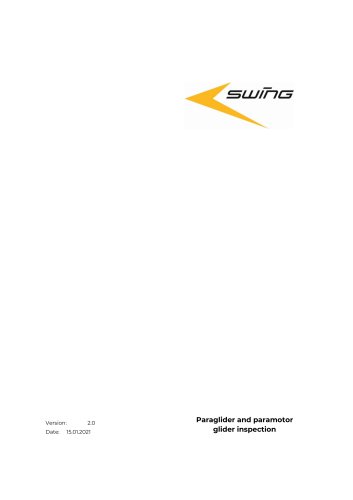
Catalog excerpts

WARNING Read this Manual before using your paraglider! © SWING Flugsportgeräte GmbH
Open the catalog to page 1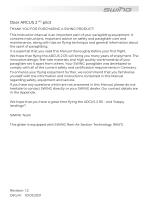
Dear ARCUS 2 RS pilot THANK YOU FOR PURCHASING A SWING PRODUCT! This Instruction Manual is an important part of your paragliding equipment. It contains instructions, important advice on safety and paraglider care and maintenance, along with tips on flying technique and general information about the sport of paragliding. It is essential that you read this Manual thoroughly before your first flight. We hope that flying the ARCUS 2 RS will bring you many years of enjoyment. The innovative design, first-rate materials and high quality workmanship of your paraglider set it apart from others....
Open the catalog to page 3
SWING Flugsportgeräte GmbH reserves the right to alter or add to the contents of this Manual at any time. You should therefore regularly visit our website: www.SWING.de There you will find further information regarding your paraglider and any updates to the owner´s manual. For detailed information on how to use the SWING website, please refer to the chapter "SWING on the World Wide Web". Express written consent from SWING Flugsportgeräte GmbH is required for any duplication of this Manual, in whole or in part (with the exception of short quotations in specialist articles), and in any form...
Open the catalog to page 4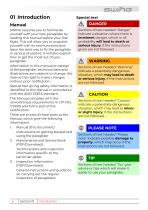
Special text Manual SWING requires you to familiarise yourself with your new paraglider by reading this Manual before your first flight. This will allow you to acquaint yourself with its new functions and learn the best way to fly the paraglider in various situations. It will also explain how to get the most out of your paraglider. Information in this manual on design of the paraglider, technical data and illustrations are subjects to change. We reserve the right to make changes without prior notification. Special text giving safety information is identified in this Manual in accordance...
Open the catalog to page 8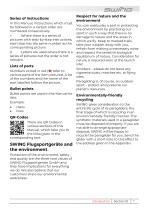
Series of instructions In this Manual, instructions which must be followed in a certain order are numbered consecutively. < Where there is a series of pictures with step-by-step instructions, each step has the same number as the corresponding picture. d Letters are used where there is a series of pictures but the order is not relevant. Lists of parts Numbers circled in red () refer to various parts of the item pictured. A list of the numbers and the name of the part labelled follows the picture. Bullet points Bullet points are used in the Manual for lists. Example: • • risers lines...
Open the catalog to page 9
02 Safety WARNING It is imperative that the instructions contained in this Manual are followed at all times. Failure to do so renders invalid the glider’s certification and/or results in loss of insurance cover. Furthermore, it could lead to serious injuries or even death. This applies in particular, but not only, to the instructions given in the sections Safety, Flying the ARCUS 2 RS, Types of Use and Dangerous Situations and Extreme Flying. Safety advice All forms of aerial sport involve certain risks. When compared with other types of aerial sport, paragliding has the lowest number of...
Open the catalog to page 10
for possible faults and the steps required to rectify any faults. SWING publishes on its website any technical safety notices and airworthiness instructions which are issued in respect of SWING products. Safety notices are released by the certification agencies and are also published on the relevant websites. You should therefore visit the safety pages of the certification agencies on a regular basis and keep up-to-date with new safety notices which cover any products relating to paragliding (refer to Appendix for addresses). Services such as RSS are also available which allow internet...
Open the catalog to page 11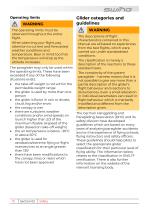
Operating limits WARNING The operating limits must be observed throughout the entire flight. When planning your flight, pay attention to current and forecasted weather conditions and temperature. Bear in mind too that the temperature will drop as the altitude increases. The paraglider may only be used within the operating limits. These have been exceeded if any of the following situations exists: • the take-off weight is not within the permissible weight range the glider is used by more than one person the glider is flown in rain or drizzle, cloud, fog and/or snow the canopy is wet there...
Open the catalog to page 12
EN/LTF certification The ARCUS 2 RS received B classification in the final classification by the licensing body. Description of flight characteristics Class B: Paragliders with good passive safety and forgiving flying characteristics. Gliders with some resistance to departures from normal flight. Description of pilot skills required For all pilots including pilots under instruction. The pilot should already have basic knowledge of how to use a paraglider. Target group and recommended flying experience Ambitious pilots wanting to move up to a B-class wing will feel just as comfortable flying...
Open the catalog to page 13
03 Technical Description General layout illustration during flight immediately gives you a sense of familiarity with a high feelgood factor and promises pure flying enjoyment. After just your first few turns in a warm thermal, you will sense that the ARCUS 2 RS features the characteristics of its big brother, the NYOS RS. Its extremely precise and direct handling makes it fun to ascend, and then the ARCUS 2 RS really demonstrates its performance potential in a valley crossing. Its stable canopy and optimised RAST system will give you the confidence to try something new and to fly further...
Open the catalog to page 14
Inflation behaviour RAST slows down the inflowing air when the paraglider is inflating. The front part of the profile which is relevant for flow thus takes shape much more quickly and the glider immediately begins to rise up from the ground. The back part of the canopy is filled with air only slowly during the subsequent stage of inflation, which results in very harmonious and smooth launch behaviour without any tendency to overshoot or launch the pilot unintentionally. Flight behaviour It is in turbulent air that RAST really puts its strengths into play, effectively stabilising the canopy...
Open the catalog to page 15All Swing Flugsportgeräte GmbH catalogs and technical brochures
-
MITO 2 RS
8 Pages
-
EscApe
24 Pages
-
Orange Cross
28 Pages
-
BRAVE 4
1 Pages
-
Connect Race lite
33 Pages
-
CONNECT REVERSE 3
32 Pages
Archived catalogs
-
Mirage RS PLUS
16 Pages
-
Spitfire 2 Plus
22 Pages
-
TWIN RS 2
2 Pages
-
ARCUS RS LITE
44 Pages
-
AGERA RS
2 Pages
-
Discus
2 Pages
-
Hybrid
2 Pages
-
scorpio
2 Pages
-
NEXUS serie
2 Pages
-
discus series
2 Pages
-
ARCUS 7
2 Pages


